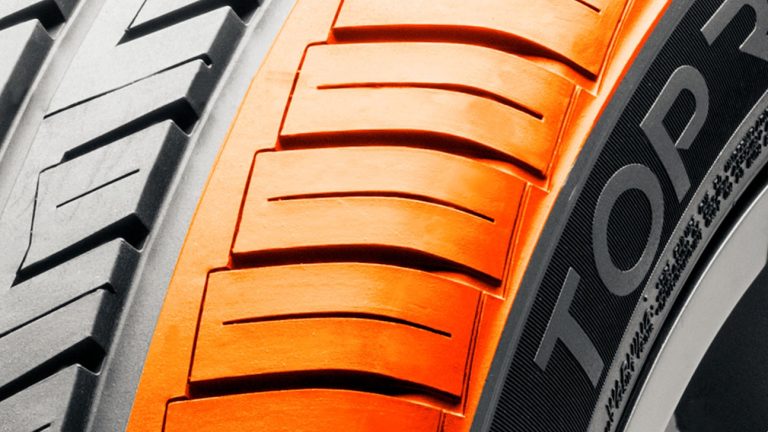The impact of tire structure on tire performance is complex and not direct. From the user’s perspective, tire performance can be summarized into two points: the first point is that the tire body must be firm and durable, that is, there will be no problems such as explosions, air leaks, etc. during the driving process of the car for no reason; The second point is that the tread must be grounded flat, which means smooth driving, reliable braking performance, and good wear resistance of the tread. To put it simply, it is nothing more than tire body and tread issues, and these two issues can still be combined because during the driving process of a car, it is precisely the structure of the tire body that affects the performance of the tread.
How tire structure determines tire performance. This also needs to be analyzed from two major aspects:
- The structure of the tire determines the shape of the tread, thereby determining the various tire performance directly related to the tread shape.
The shape and variation of the tire tread during driving are important factors affecting tire performance. Meridian tires benefit from the clamping effect of the belt layer, and under normal inflation pressure, the crown and shoulder of the tire are basically kept on the same line. However, for heavy-duty tires, due to the high inflation pressure, the crown is slightly raised, but the curvature is not as large as that of diagonal tires.
The performance affected by the shape of the tread includes:
- Driving smoothness
As the tread moves from an arc to a straight line, the effective width of the tread contact increases until the shoulder and crown of the tire land simultaneously, significantly improving the lateral support of the car and making it more stable.
- Shortened braking distance
A flat tread is beneficial for maintaining adhesion to the ground, thereby shortening the braking distance.
- Rolling resistance
When the car is stationary, there is a contact surface between the tread and the ground, commonly known as an imprint. Due to the curved tread of diagonal tires, their imprints are elliptical, with a larger front to back distance and narrower side distance, while radial tires have imprints that are closer to rectangular, with shorter front to back distance and larger side distance. Both have almost equal imprint areas under the same pressure. This is the fundamental reason why radial tires have lower rolling resistance.
- Anti slip
Whether driving in a straight line or turning, a flat tread always allows the tire pattern to make more effective contact with the ground, enhance tire grip, and reduce the possibility of sideslip.
- Wear resistance
Why does a flat tread have better wear resistance? The most basic reason is still the shape of the tread. Because:
Firstly, during driving, the tread shape of radial tires remains basically unchanged, resulting in less useless work, less heat generation, and slower material fatigue and aging compared to diagonal tires.
Secondly, the flatter the tire surface, the more uniform the force, especially the significantly reduced pressure on the tire crown, and the reduction of force is a necessary condition for improving the wear resistance of the tire surface. An important factor in tire tread wear is the scraping force on the ground. The greater the scraping force, the faster the tread wear. For tread with a high crown, the pressure borne by the crown is the greatest, gradually weakening towards the shoulder, resulting in the maximum scraping force experienced by the shoulder. This causes the tire to always wear from the crown and then expand to the entire tread surface. Some radial tires may wear the crown, which is because the crown is too high.
Thirdly, it is not easy to experience eccentric wear.
- The tire structure also directly determines the performance of the tire body itself. Mainly manifested in:
- The circumferential consistency of the centerline of the tire crown.
The belt layer of radial tires can ensure that the centerline of the tread is consistent with the centerline of the crown, which means that the centrifugal force balance during high-speed rotation is significantly better than that of diagonal tires.
- Tire sidewall rigidity and maintainability
From a side view, the arrangement of the steel wires in radial tires is similar to a fanbone, with each wire located on the radial line. As radial tires generally have a single-layer tire structure, the steel wires do not overlap or cross, and the gaps between the steel wires are sealed by rubber (commonly known as “sidewall rubber”). The sidewall of radial tires is fan-shaped, and once punctured by external forces, it is prone to curtain cracking and cannot be repaired.
- Fetal thermogenesis
There are two main parts of fetal heat generation, one comes from the fetal skeleton material and sidewall rubber, and the other comes from the air inside the fetus. The main reason for tire body heat generation is: firstly, the tire body undergoes deformation and deformation under load. When a car turns or the road surface is uneven, the tire shape is prone to deformation due to the influence of road forces and the weight of the car. The second reason is that the dynamic load of the tires constantly changes while the car is driving, so the tire body will stretch and contract. The third is the frequent compression and flow of air inside the tire caused by changes in the shape of the tire and the expansion and contraction of the skeleton material. In fact, the heat generation of tires has two key elements, namely the internal energy of the material and motion. The internal energy of a material is excited to generate heat, which is one of the fundamental properties of matter, and motion is the excitation condition. The design of tires is to minimize unnecessary movement as much as possible, only in this way can the use of the same * * material naturally reduce heat generation.
- Load capacity performance
The load-bearing performance of a tire is not only determined by the strength and quantity of the skeleton material, but also by the strength of the steel wire ring. The angle between the tire body wire and the wire ring of a radial tire is a right angle. It is generally believed that the arrangement of radial tires can better utilize the strength performance of the skeleton material, but this is actually a misunderstanding. The final load-bearing component of the tire is the steel wire ring, and both ends of the tire body steel wire are fixed to the steel wire ring. The force acting on a tire is not just a simple form of tension, but mainly the external expansion force caused by gas internal pressure. This swelling force is perpendicular to the inner wall of the tire. In other words, regardless of the angle between the cord and the steel wire, the force exerted by internal pressure on the cord is always vertical. Furthermore, when the two ends are fixed and the distance between the endpoints remains constant, whether it is a fiber or a steel wire, its physical properties such as fracture strength and tensile strength will not change due to changes in the angle between the fixed point or line (such as a wire ring) and itself. That is to say, the structural design of a tire depends on the strength of the steel wire ring, skeleton material, as well as the size of the tire cavity and inflation pressure.
There is also a viewpoint that 70% of the load strength of radial tires is concentrated on the belt layer, but this is not the case in reality. The strength of the belt load is inversely proportional to the aspect ratio of the tire section. The smaller the aspect ratio, the greater the strength of the belt load, and vice versa.



